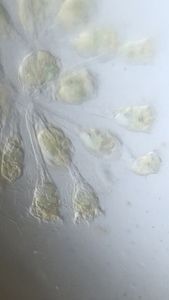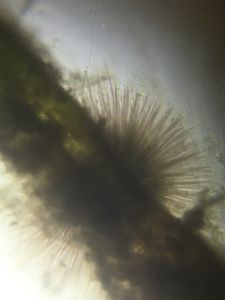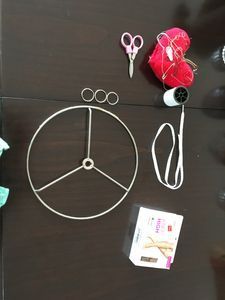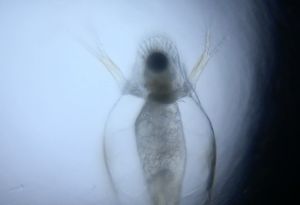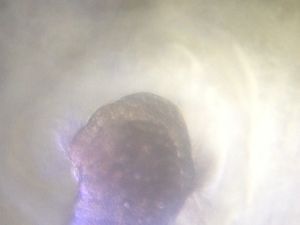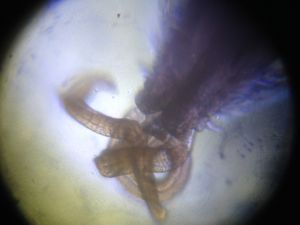Pests in the Garden
 Sep 25, 2015 • 9:12 PM UTC
Sep 25, 2015 • 9:12 PM UTC Unknown Location
Unknown Location 140x Magnification
140x Magnification Microorganisms
Microorganisms
Matthew Rossi
I'm a novelist, essayist, and a writing consultant. I work in the writing centers at Columbia and Baruch University and explore research into the overlap of maker cultures and writing. My work with the Foldscope tends to focus on finding wild creatures in urban spaces and looking at how human works are shaped by the movements of the biosphere.
40posts
105comments
4locations
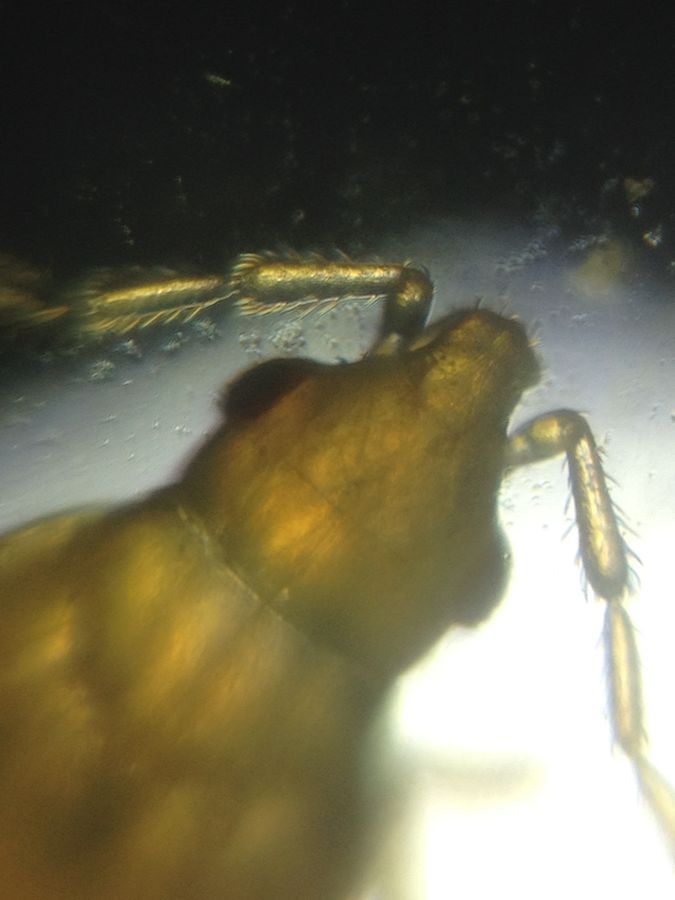
I’m on a hunt for a small enough spider to image while it’s alive, so I’ve been hunting in the grass and in my small porch garden for anyone who fits that bill. There’s a surprising amount of wild space in the city, and even in a place like Brooklyn, plenty of creatures make their homes, so I’ve been pleasantly surprised to find webs and crawlies on most of my hunts. I even recently found a chrysalis for a cabbage looper moth on the underside of a basil leaf in my garden (unfortunately it hatched before I had a chance to image it; a missed opportunity, but I can’t begrudge the little creature its good fortune, even if it did eat half my basil). Yet, I’ve had a hard time finding tiny spiders.
I was thrilled, then, when I came out to find that my tomato plants were covered in delicate webs, with many small dots walking among them. Surely, I thought, this was a sign of recent spider hatching. Not so. I was unpleasantly surprised to find that these were not spiders, but spider mites. And that they had been laying eggs.
I was thrilled, then, when I came out to find that my tomato plants were covered in delicate webs, with many small dots walking among them. Surely, I thought, this was a sign of recent spider hatching. Not so. I was unpleasantly surprised to find that these were not spiders, but spider mites. And that they had been laying eggs.
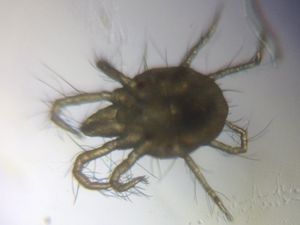

The jaws on that little thing are pretty frightening; which makes me glad they’re only used for drinking sap from plants (my tomatoes in this case…which is not great). Imagining the mite under a slide cover seemed to press it down a little more than I wanted, so I took the advice from an earlier post on this site and filmed them on their leaves instead. This both illuminated a lot about their world to me (the relatively mountainous terrain of the tomato leaf to their tiny bodies) and made me realize how bad the infestation was. I had assumed I caught only a couple of mites, but upon looking at them on the leaf, realized I had at least ten on a very small sample size. And again, the eggs.
It also made me realize how social they are, constantly touching and interacting with each other, even if only for the purpose of mating and colony protection. Watching one clean itself as it walked along my slide cover (because of course, they wouldn’t only stay on their leaf; like me, they had to explore), I thought about the overlap of thought and reaction. I know the spider mite does not think (it is questionable whether it even has a nervous system), but here it engages in a behavior I find recognizable as something my cat does.
An attempt at taking a high-mag video revealed a lot more detail of the movement of fluids within it.
Of course, since I was already looking for pests on the tomato plants, this was a good opportunity to hunt around a bit and figure out who has been eating my other plants. The garden is open to the street and confined to pots. For whatever reason, many bugs like to make it their homes (see above about the chrysalis). A little further hunting and I found aphids dwelling on some of my herbs and my tomatoes (what is it with the tomatoes?). I nabbed a tiny reddish insect that I take to be one of the nymphs of the aphids and was happy to have a chance to take some images of it.
Aphid is my best identification of it, though it might also be the nymph of a scentless plant bug (according to Google). Tiny and swift, this little one didn’t want me to look at it. Only by placing it under a slide cover and holding it in place was I able to get a steady glimpse of it. The scope shows me the inner working of its gut, and the mechanics of its moving legs.
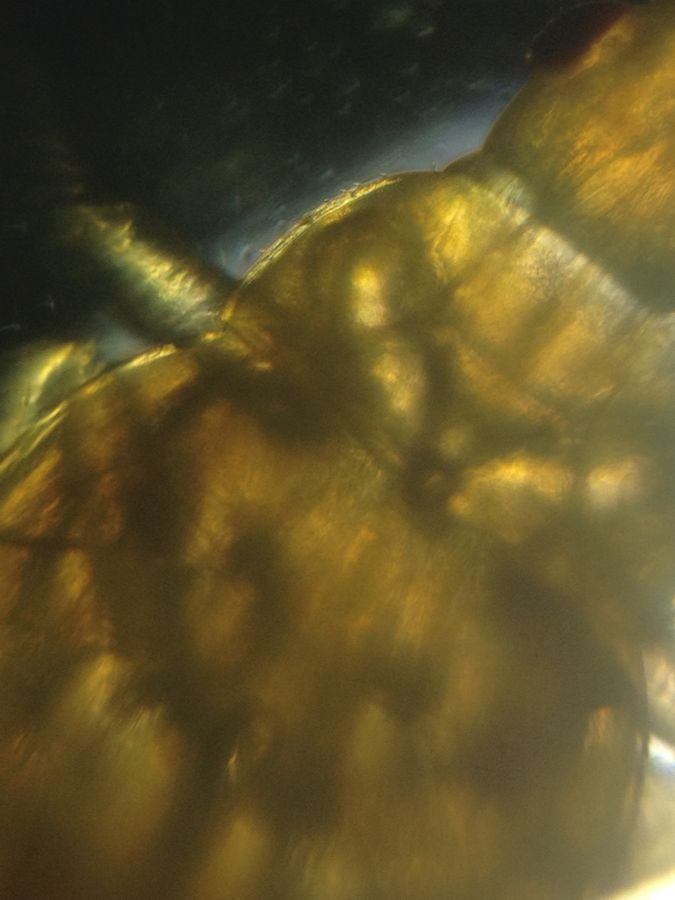
It shows me the way it moves, also, when it runs away from my viewer.
Eventually, the aphid found its way back outside (to another plant) and the spider mites…well, I’m still trying to control their colony. It’s late in the season, but I want all the tomatoes I can get.
I’ve observed before that looking at traditionally strange and monstrous creatures up close often has the effect of making me feel like I can more easily relate their existence to my own. Perhaps it is their resemblance to ticks, or perhaps it’s the fact that they’re eating my tomatoes, but that hasn’t happened with the spider mites.
I suppose the lesson here is that the ecosystem doesn’t much care whether I find it beautiful or cute or not. The spider mites on my tomato will live their lives as they want, perfectly evolved for their purpose. And our lives will clash and clash again, so long as my goals of growing fresh vegetables provide opportunity for them to meet their goal of eating sap. So the best I can do, assuming I don’t want to give up my garden, is to care for my plants as best I can and make peace with the fact that my garden is not mine alone, that even that small space can be home and food for caterpillars and aphids and mites and spiders (hopefully), all of whom are just doing the same thing I am in the world. Working for survival in a big city.
It’s also a sign that next spring I need to go hunting for some ladybug larvae and praying mantis eggs. My garden could use some apex predators.
I’ve observed before that looking at traditionally strange and monstrous creatures up close often has the effect of making me feel like I can more easily relate their existence to my own. Perhaps it is their resemblance to ticks, or perhaps it’s the fact that they’re eating my tomatoes, but that hasn’t happened with the spider mites.
I suppose the lesson here is that the ecosystem doesn’t much care whether I find it beautiful or cute or not. The spider mites on my tomato will live their lives as they want, perfectly evolved for their purpose. And our lives will clash and clash again, so long as my goals of growing fresh vegetables provide opportunity for them to meet their goal of eating sap. So the best I can do, assuming I don’t want to give up my garden, is to care for my plants as best I can and make peace with the fact that my garden is not mine alone, that even that small space can be home and food for caterpillars and aphids and mites and spiders (hopefully), all of whom are just doing the same thing I am in the world. Working for survival in a big city.
It’s also a sign that next spring I need to go hunting for some ladybug larvae and praying mantis eggs. My garden could use some apex predators.
Sign in to commentNobody has commented yet... Share your thoughts with the author and start the discussion!
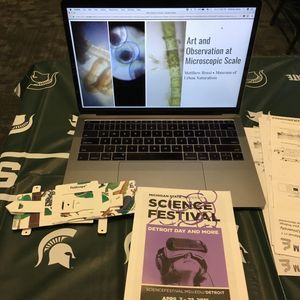
 0 Applause
0 Applause 0 Comments
0 Comments




